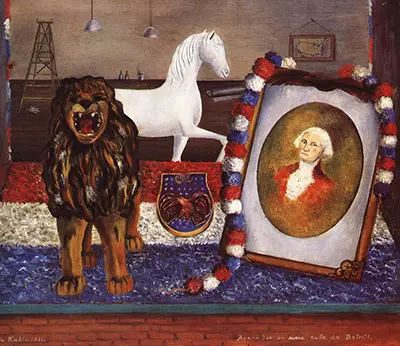Framed by the shop window, the painting includes a papier-mâché lion and horse similar to those owned by Frida, as well as a portrait of George Washington wrapped in flower garlands. Full of patriotic colour and Americana, this work was likely inspired by a Fourth of July display window that Frida walked past in either Detroit or New York, where she was likely living at the time dated on this work (1931).
Others have attributed the date of this work to 1932 since she was likely in Detroit at this time. It’s possible that she drew inspiration from a similar shop window in New York, where she was in 1931 and completed the work in Detroit in 1932. Colour is mostly focused on the patriotic American red, white, and blue. This can be found in both the flower garland wrapped around the portrait of George Washington as well as for the base of the display. There is a distinct lack of vibrancy in the colour palette used elsewhere, as the background appears to be an empty shop with only a step ladder and a United States map in the rear.
These details clearly indicate the symbology and meaning of the painting. It’s American pride and patriotism at the forefront. Perhaps Kahlo felt homesick and was reminded of her country and its patriotism by the shop window found in Detroit. The background forms the other half of her typical duality theme: a vacant shop which is possibly under construction symbolising that America has a veneer of pomp and pride but is still teething as a nation and requires further refinement.
In 1950, Frida said the following regarding this work: "In Detroit, I painted a very ugly painting that gives me a lot of sadness when I see it, of a showcase with many things in it." The medium is oil on metal. It was completed in either 1931 or 1932. It is currently in the Collection of Mr and Mrs Abel Holtz.

